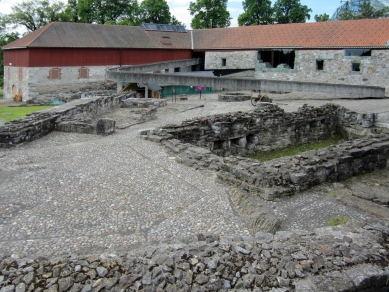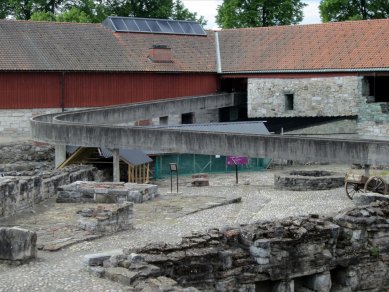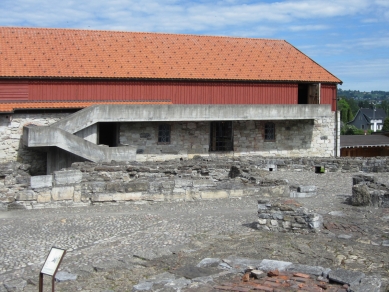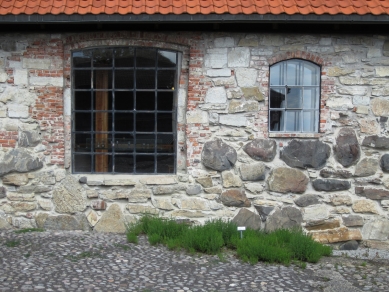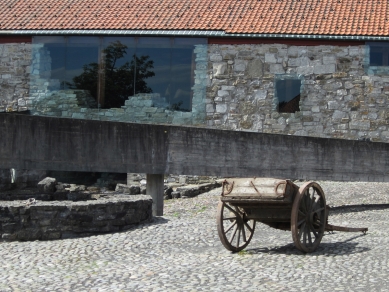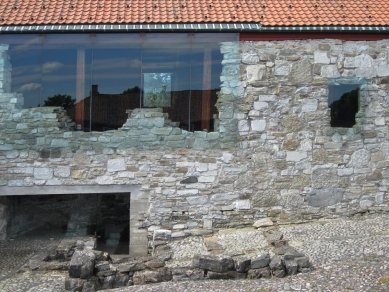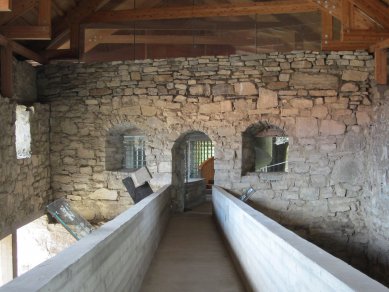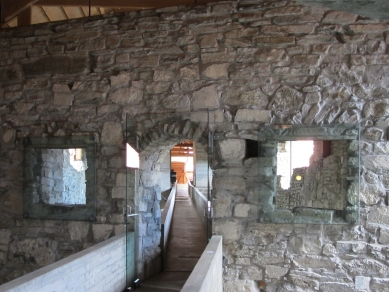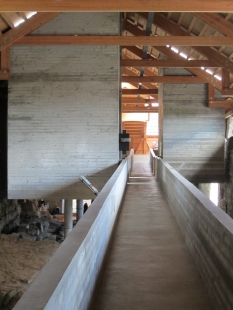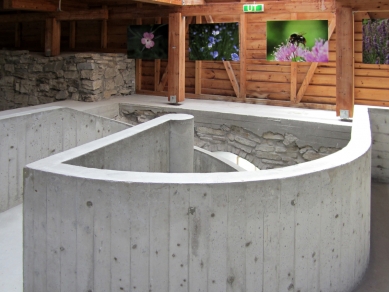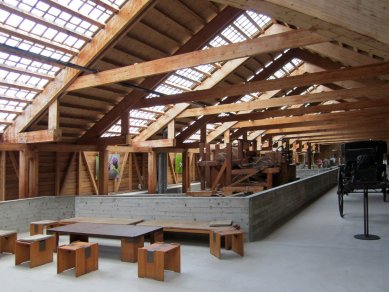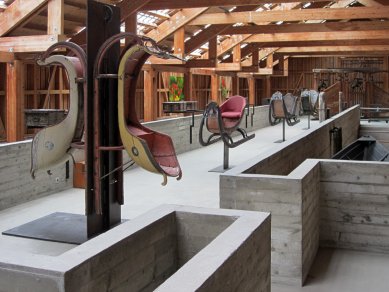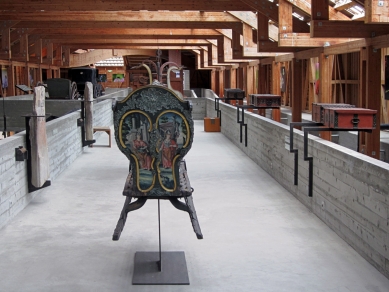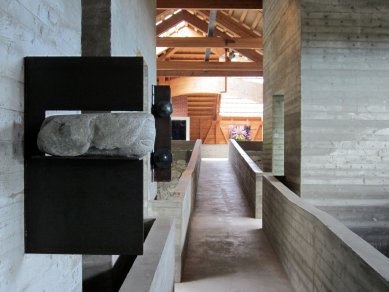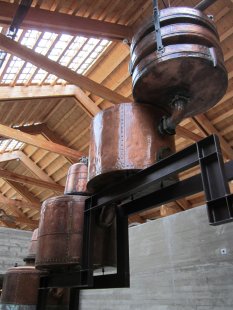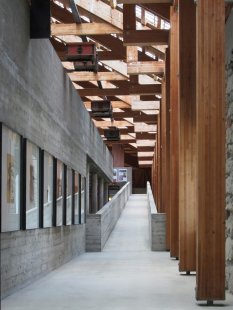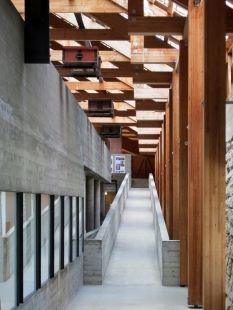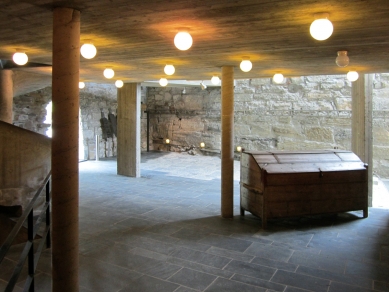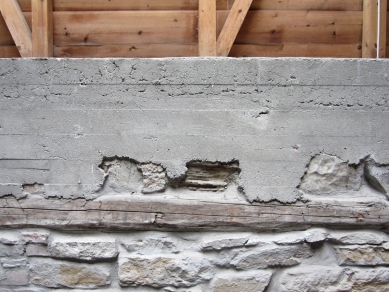
Hedmark Museum

The Historical Museum of Hedmark County was established on the site of a medieval bishop's palace near the shores of Norway's largest lake, Mjøsa. The building later fell into disrepair, and at the beginning of the nineteenth century, a granary was built on the site. That, now in ruins, came under the ownership of the county museum after World War II. Initially, detailed archaeological surveys began on site, which would continue even after the construction of a new museum. The basis of the collections became a number of finds from this location; to these, exhibits documenting rural life in the region were added.
Sverre Fehn left a large portion of the excavations exposed, both outside and inside, as well as what remained of the historical masonry. The entire building thus allows for a continuous dialogue with the past. The roofing on wooden trusses alternates between tiles and glass panels; natural light mixes with lateral light that enters through openings in the walls. The architect left these openings in their original state and only covered them with glass. The insertion is intentionally contrasting. In the main three wings of the building, visitors navigate built-in floors and ramps made of concrete. On one hand, the concrete is raw, with visible formwork; on the other, it is smooth, resting on round supporting columns. Various options are available for the visitor to traverse the museum; thus, the visit unfolds like a story on multiple levels.
Sverre Fehn thoroughly contemplated the concept of the museum as a meeting place with history. In connection with the Hamar museum, he noted among other things: “Only through the new embodiment of the moment can we begin a dialogue with the past.” The museum's interior is continuous; however, rarer and sacred objects are placed in three concrete "towers." At the same time, some routes lead outside, with the most prominent being a narrow, curved ramp leading to the excavations in the courtyard. A dialogue is thus established between the exterior and the interior: the past is continuously reminded to the viewer as a series of traces from the history of a specific place. An integral part of the architecture is the installation of exhibits, which the architect mostly placed on black iron brackets, freely in the space.
The museum is not heated and is therefore only open during the summer season. There is no pretense about stopping the decay of things – that is only slowed down: “In a materialistic world, museums are cathedrals for the worship of the past. We are trying to deny our own death, refusing to accept the destruction of objects; we build these giant incubators and equip them with the most expensive improvements – ventilation, eternal preservation (...). Only the life of those things is utterly destroyed.”
In the southern wing, completed in 1973, there is an auditorium used for cultural purposes. The museum also includes the ruins of a Gothic cathedral nearby, which were covered in 1998 with a tall structure made of glass and steel designed by architect Kjell Lund. Thus, two different ways of bringing history to the forefront stand out in close proximity: while the roofing of the cathedral has become a new landmark of the place, Fehn's refined approach combines growth with an emphasis on horizontality.
The Hamar museum is regarded as one of Sverre Fehn's masterpieces and is often compared to Scarpa's Museo del Castelvecchio in Verona. In the Czech context, it can be compared to the Olomouc Archdiocesan Museum by the HŠH studio.
Literature
Christian Norberg-Schulz, Gennaro Postiglione, Francesco Dal Co, Sverre Fehn: Works, Projects, Writings, 1949-1996, 129-144.
– Per Olaf Fjeld, Sverre Fehn. The Thought of Construction, New York 1983, pp. 129-140.
– Per Olaf Fjeld, Sverre Fehn. The Pattern of Thoughts, New York 2009, pp. 112-131.
– Marianne Yvenes, Eva Madshus (eds.), Architect Sverre Fehn, intuition – reflection – construction, Oslo 2008, 92-97.
– Ingerid Helsing Almaas (ed.), Sverre Fehn. Projects and Reflections, Special Issue, Arkitektur N 7/2009, pp. 10-27.
Sverre Fehn left a large portion of the excavations exposed, both outside and inside, as well as what remained of the historical masonry. The entire building thus allows for a continuous dialogue with the past. The roofing on wooden trusses alternates between tiles and glass panels; natural light mixes with lateral light that enters through openings in the walls. The architect left these openings in their original state and only covered them with glass. The insertion is intentionally contrasting. In the main three wings of the building, visitors navigate built-in floors and ramps made of concrete. On one hand, the concrete is raw, with visible formwork; on the other, it is smooth, resting on round supporting columns. Various options are available for the visitor to traverse the museum; thus, the visit unfolds like a story on multiple levels.
Sverre Fehn thoroughly contemplated the concept of the museum as a meeting place with history. In connection with the Hamar museum, he noted among other things: “Only through the new embodiment of the moment can we begin a dialogue with the past.” The museum's interior is continuous; however, rarer and sacred objects are placed in three concrete "towers." At the same time, some routes lead outside, with the most prominent being a narrow, curved ramp leading to the excavations in the courtyard. A dialogue is thus established between the exterior and the interior: the past is continuously reminded to the viewer as a series of traces from the history of a specific place. An integral part of the architecture is the installation of exhibits, which the architect mostly placed on black iron brackets, freely in the space.
The museum is not heated and is therefore only open during the summer season. There is no pretense about stopping the decay of things – that is only slowed down: “In a materialistic world, museums are cathedrals for the worship of the past. We are trying to deny our own death, refusing to accept the destruction of objects; we build these giant incubators and equip them with the most expensive improvements – ventilation, eternal preservation (...). Only the life of those things is utterly destroyed.”
In the southern wing, completed in 1973, there is an auditorium used for cultural purposes. The museum also includes the ruins of a Gothic cathedral nearby, which were covered in 1998 with a tall structure made of glass and steel designed by architect Kjell Lund. Thus, two different ways of bringing history to the forefront stand out in close proximity: while the roofing of the cathedral has become a new landmark of the place, Fehn's refined approach combines growth with an emphasis on horizontality.
The Hamar museum is regarded as one of Sverre Fehn's masterpieces and is often compared to Scarpa's Museo del Castelvecchio in Verona. In the Czech context, it can be compared to the Olomouc Archdiocesan Museum by the HŠH studio.
Literature
Christian Norberg-Schulz, Gennaro Postiglione, Francesco Dal Co, Sverre Fehn: Works, Projects, Writings, 1949-1996, 129-144.
– Per Olaf Fjeld, Sverre Fehn. The Thought of Construction, New York 1983, pp. 129-140.
– Per Olaf Fjeld, Sverre Fehn. The Pattern of Thoughts, New York 2009, pp. 112-131.
– Marianne Yvenes, Eva Madshus (eds.), Architect Sverre Fehn, intuition – reflection – construction, Oslo 2008, 92-97.
– Ingerid Helsing Almaas (ed.), Sverre Fehn. Projects and Reflections, Special Issue, Arkitektur N 7/2009, pp. 10-27.
Ondřej Hojda, June 2013
The English translation is powered by AI tool. Switch to Czech to view the original text source.
0 comments
add comment



